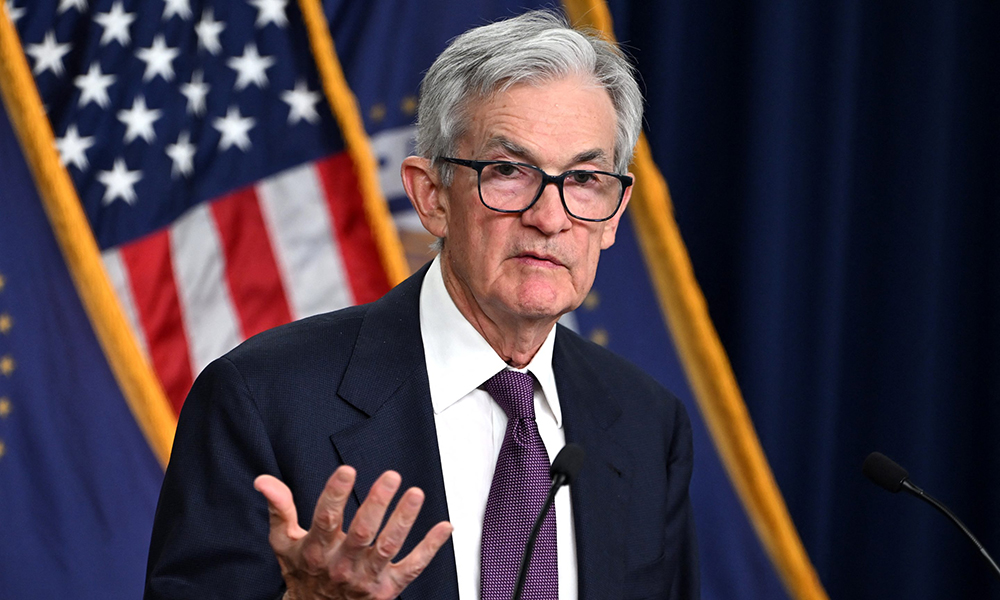
2024年最后几个月,为了降低借款成本,美联储终于在万众期待中降息。然而,债券市场却拒绝配合美联储的动作,上周的固定收益产品抛售延续到了本周一。周一上午,基准10年期国债的收益率短暂突破了4.8%,达到自2023年11月以来的最高水平,而30年期国债的收益率接近5%。债券价格下降时,其收益率就会上升。债券收益率升高,反过来会影响抵押贷款和各类贷款的成本。
出现这种情况的一个主要原因是上周远超预期的就业报告,使华尔街好奇美联储在2025年是否会继续降息。与此同时,随着唐纳德·特朗普即将就任,有人担心这位新当选总统的关税、减税和大规模驱逐非法移民等政策可能会导致通胀加剧。无论如何,大幅升高的收益率正在对股票市场产生影响,而且一些市场观察者将债券视为潜在的投资机会。
去年10月,随着对经济衰退的担忧减弱,债券收益率在强劲就业数据公布后开始上升。两个月后,联邦开放市场委员会(Federal Open Market Committee)暗示2025年的降息次数将少于之前的预期,令投资者大失所望。联信银行(Comerica Bank)首席经济学家比尔·亚当斯在周一的一份报告中指出,联邦开放市场委员会12月开会的会议记录显示,美联储的决策者们一致认为,通货膨胀升高的风险增加。
然后是上周五的就业报告。美国劳工统计局(Bureau of Labor Statistics)披露的数据显示,去年12月,非农就业人数增加25.6万人,超出预期的15.5万。强劲的就业数据让投资者担心美联储会继续降息,还是改变政策进行加息以应对物价上涨。
这种担忧影响了股市,导致标普500指数在过去五天内下跌了2.5%。贝雅私人财富管理公司(Baird Private Wealth Management)的投资策略师罗斯·梅菲尔德在上周五的一份报告中表示,要分析最近的市场波动,首先应该从长期债券收益率着手。
他指出,更高的借款成本(目前抵押贷款利率接近7%)给整体经济带来了压力。他补充道,更高利率还会减少企业利润和压缩估值倍数,从而影响股价。
梅菲尔德表示:“债券收益率在美联储降息后上升是不寻常的,而美联储在经济衰退尚未显现的情况下选择降息的经济背景同样不寻常。收益率的上升可能反映了以下几个因素的综合作用:强于预期的经济增长、对第二波通货膨胀的担忧(可能由关税和移民政策的变化引发)、持续的预算赤字和国家债务问题,以及进入2025年后美联储可能会采取更强硬的政策。”
美债抛售是否会带来机会?
讽刺的是,美债抛售可能给投资者重新进入固定收益市场创造条件。例如,随着投资者通过持有美国政府债务获得的无风险回报增加,股票对投资者来说可能显得更昂贵。
《华尔街日报》的乔恩·辛德雷乌最近认为,全球债券收益率上升不应让投资者担心发达国家会出现债务违约。他写道:“更重要的是,与通胀挂钩的美国国债也被抛售,这表明市场并不认为经济过热和关税是一个严重的通胀问题。”
相反,他认为长期收益率上升是合理的,因为投资者排除了短期内经济衰退的可能性,并要求长期锁定他们的资金应该带来更高的回报。这解释了10年期和30年期国债等资产的期限溢价增加的原因,期限溢价补偿了投资者所承担的因利率随时间变化带来的风险。
上周,美国银行(Bank of America)的经济学家宣布美联储的降息周期应该结束。 美国银行信用策略师尤里·塞林格、吉恩-提亚哥·哈姆和素贤·玛丽·李在上周五的一份报告中写道:“美联储加息的门槛仍然很高。这限制了加息的幅度,以及扩大(投资级)利差的幅度。”
不过,千万不要试图向想买房的人兜售这种乐观情绪。(财富中文网)
译者:刘进龙
审校:汪皓
2024年最后几个月,为了降低借款成本,美联储终于在万众期待中降息。然而,债券市场却拒绝配合美联储的动作,上周的固定收益产品抛售延续到了本周一。周一上午,基准10年期国债的收益率短暂突破了4.8%,达到自2023年11月以来的最高水平,而30年期国债的收益率接近5%。债券价格下降时,其收益率就会上升。债券收益率升高,反过来会影响抵押贷款和各类贷款的成本。
出现这种情况的一个主要原因是上周远超预期的就业报告,使华尔街好奇美联储在2025年是否会继续降息。与此同时,随着唐纳德·特朗普即将就任,有人担心这位新当选总统的关税、减税和大规模驱逐非法移民等政策可能会导致通胀加剧。无论如何,大幅升高的收益率正在对股票市场产生影响,而且一些市场观察者将债券视为潜在的投资机会。
去年10月,随着对经济衰退的担忧减弱,债券收益率在强劲就业数据公布后开始上升。两个月后,联邦开放市场委员会(Federal Open Market Committee)暗示2025年的降息次数将少于之前的预期,令投资者大失所望。联信银行(Comerica Bank)首席经济学家比尔·亚当斯在周一的一份报告中指出,联邦开放市场委员会12月开会的会议记录显示,美联储的决策者们一致认为,通货膨胀升高的风险增加。
然后是上周五的就业报告。美国劳工统计局(Bureau of Labor Statistics)披露的数据显示,去年12月,非农就业人数增加25.6万人,超出预期的15.5万。强劲的就业数据让投资者担心美联储会继续降息,还是改变政策进行加息以应对物价上涨。
这种担忧影响了股市,导致标普500指数在过去五天内下跌了2.5%。贝雅私人财富管理公司(Baird Private Wealth Management)的投资策略师罗斯·梅菲尔德在上周五的一份报告中表示,要分析最近的市场波动,首先应该从长期债券收益率着手。
他指出,更高的借款成本(目前抵押贷款利率接近7%)给整体经济带来了压力。他补充道,更高利率还会减少企业利润和压缩估值倍数,从而影响股价。
梅菲尔德表示:“债券收益率在美联储降息后上升是不寻常的,而美联储在经济衰退尚未显现的情况下选择降息的经济背景同样不寻常。收益率的上升可能反映了以下几个因素的综合作用:强于预期的经济增长、对第二波通货膨胀的担忧(可能由关税和移民政策的变化引发)、持续的预算赤字和国家债务问题,以及进入2025年后美联储可能会采取更强硬的政策。”
美债抛售是否会带来机会?
讽刺的是,美债抛售可能给投资者重新进入固定收益市场创造条件。例如,随着投资者通过持有美国政府债务获得的无风险回报增加,股票对投资者来说可能显得更昂贵。
《华尔街日报》的乔恩·辛德雷乌最近认为,全球债券收益率上升不应让投资者担心发达国家会出现债务违约。他写道:“更重要的是,与通胀挂钩的美国国债也被抛售,这表明市场并不认为经济过热和关税是一个严重的通胀问题。”
相反,他认为长期收益率上升是合理的,因为投资者排除了短期内经济衰退的可能性,并要求长期锁定他们的资金应该带来更高的回报。这解释了10年期和30年期国债等资产的期限溢价增加的原因,期限溢价补偿了投资者所承担的因利率随时间变化带来的风险。
上周,美国银行(Bank of America)的经济学家宣布美联储的降息周期应该结束。 美国银行信用策略师尤里·塞林格、吉恩-提亚哥·哈姆和素贤·玛丽·李在上周五的一份报告中写道:“美联储加息的门槛仍然很高。这限制了加息的幅度,以及扩大(投资级)利差的幅度。”
不过,千万不要试图向想买房的人兜售这种乐观情绪。(财富中文网)
译者:刘进龙
审校:汪皓
The long-awaited interest rate cuts from the Federal Reserve in the final months of 2024 aimed to lower borrowing costs. Bond markets are refusing to cooperate, however, as last week’s fixed-income sell-off carried into Monday. The yield on the benchmark 10-year Treasury, which rises as the price of the bond falls, briefly surged above the 4.8% mark Monday morning, its highest level since November 2023, while its 30-year counterpart is on the cusp of hitting 5%. Those rising rates will in turn carry over to the cost of mortgages and loans of all sorts.
A big reason for all this is last week’s blowout jobs report, which left Wall Street wondering whether the Fed will continue its rate-cutting regime in 2025. Meanwhile, on the cusp of Donald Trump’s inauguration, there are fears the President-elect’s policies on tariffs, tax cuts, and mass deportations could prove inflationary. Whatever the case, a steepening yield curve is weighing on stocks, and some market watchers are eyeing bonds as a potential opportunity for investors.
Yields began their upswing off the back of strong monthly jobs data in October as recession fears eased. Two months later, the Federal Open Market Committee disappointed investors by signaling fewer cuts in 2025 than previously expected. As Bill Adams, chief economist at Comerica Bank, noted in a note on Monday, the minutes of the committee’s December meeting showed the Fed’s decision makers all agreed upside risk to inflation had increased.
Then came Friday’s jobs report. The Bureau of Labor Statistics revealed nonfarm payrolls grew by 256,000 in December, blowing away the expected number of 155,000. The strong labor data spooked investors now wondering whether the Fed will slash rates at all—or even reverse course and hike rates to fight rising prices.
Those fears have hit the stock market, leading the S&P 500 to sink 2.5% over the past five days. When unpacking the recent market volatility, however, long-term bond yields are the place to start, Ross Mayfield, an investment strategist at Baird Private Wealth Management, said in a note Friday.
Elevated borrowing costs—mortgage rates currently sit near 7% —burden broader economic activity, he noted. Higher interest rates also dent corporate profits and compress valuation multiples, he added, which weighs on stock prices.
“This is an unusual move following Fed rate cuts, but then again, so is the economic backdrop of the Fed cutting rates without a recession looming,” Mayfield said. “The move in yields likely reflects some combination of stronger-than-expected economic growth, fears of a second wave of inflation (potentially spurred on by changes to tariff and immigration policy), the lingering budget deficit/national debt issue, and a more hawkish Fed entering 2025.”
Could the bond sell-off present opportunity?
Ironically, the bond sell-off may be creating conditions for investors to jump back in to the fixed-income market. Stocks may appear more expensive to investors, for example, as the risk-free return that investors can obtain by holding U.S. government debt increases.
The Wall Street Journal’s Jon Sindreu recently argued that the surge in yields across the globe shouldn’t make investors worried about developed countries defaulting on their debt. “More important, inflation-linked Treasurys have sold off too,” he wrote, “belying the idea that markets see a hot economy and tariffs as a serious inflationary problem.”
Instead, he argued the jump in long-term yields makes sense as investors rule out the possibility of an economic downturn in the short run and demand a higher return for locking up their money for extended periods. That explains the increase in the term premium for assets like the 10- and 30-year Treasury, which compensates investors for the risk of interest rates changing over time.
Last week, Bank of America economists declared that the Fed’s rate-cutting cycle should be over. “Still, the bar for Fed hikes remains high,” BofA credit strategists Yuri Selinger, Jean-Tiago Hamm, and Sohyun Marie Lee wrote in a note Friday. “That puts a limit on how much higher rates can go, and how much more [investment grade] spreads could widen.”
Just don’t attempt to sell all this optimism to someone trying to buy a house.






